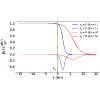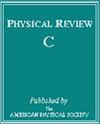低能重离子碰撞中的电磁场与重子停止
IF 3.4
2区 物理与天体物理
Q1 Physics and Astronomy
引用次数: 0
摘要
我们研究了在 sNN=4-20GeV 的低能 Au+Au 对撞中重子停止对真空中电磁场的时间演化的影响。通过采用非零减速参与核子的参数化速度曲线,将重子停止纳入蒙特卡洛格劳伯模型。与减速消失的情况相比,这些减速参与者的存在导致电磁场的中心性和 sNN 依赖性发生明显变化。重子停止对电场和磁场的影响各不相同,它们的各组成部分也表现出差异。我们观察到,在存在减速的情况下,场强与 sNN 的近似线性关系略有改变。此外,在重子停止的情况下,电场的纵向分量在晚期变得很重要。本文章由计算机程序翻译,如有差异,请以英文原文为准。

Electromagnetic fields in low-energy heavy-ion collisions with baryon stopping
We investigate the impact of baryon stopping on the temporal evolution of electromagnetic fields in vacuum at low-energy Au+Au collisions with . Baryon stopping is incorporated into the Monte Carlo Glauber model by employing a parametrized velocity profile of participant nucleons with nonzero deceleration. The presence of these decelerating participants leads to noticeable changes in the centrality and dependence of electromagnetic fields compared to scenarios with vanishing deceleration. The influence of baryon stopping differs for electric and magnetic fields, also exhibiting variations across their components. We observe slight alteration in the approximate linear dependency of field strengths with in the presence of deceleration. Additionally, the longitudinal component of the electric field at late times becomes significant in the presence of baryon stopping.
求助全文
通过发布文献求助,成功后即可免费获取论文全文。
去求助
来源期刊

Physical Review C
物理-物理:核物理
CiteScore
5.70
自引率
35.50%
发文量
0
审稿时长
1-2 weeks
期刊介绍:
Physical Review C (PRC) is a leading journal in theoretical and experimental nuclear physics, publishing more than two-thirds of the research literature in the field.
PRC covers experimental and theoretical results in all aspects of nuclear physics, including:
Nucleon-nucleon interaction, few-body systems
Nuclear structure
Nuclear reactions
Relativistic nuclear collisions
Hadronic physics and QCD
Electroweak interaction, symmetries
Nuclear astrophysics
 求助内容:
求助内容: 应助结果提醒方式:
应助结果提醒方式:


